The AMD Radeon R9 290 Review
by Ryan Smith on November 5, 2013 12:01 AM EST- Posted in
- GPUs
- AMD
- Radeon
- Hawaii
- Radeon 200
Crysis: Warhead
Up next is our legacy title for 2013/2014, Crysis: Warhead. The stand-alone expansion to 2007’s Crysis, at over 5 years old Crysis: Warhead can still beat most systems down. Crysis was intended to be future-looking as far as performance and visual quality goes, and it has clearly achieved that. We’ve only finally reached the point where single-GPU cards have come out that can hit 60fps at 1920 with 4xAA, never mind 2560 and beyond.
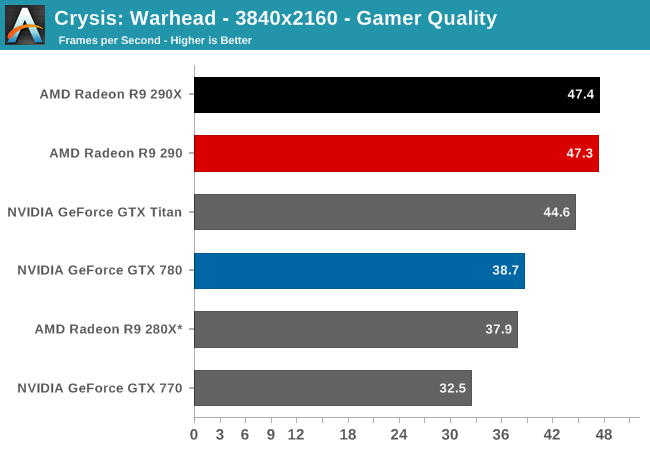
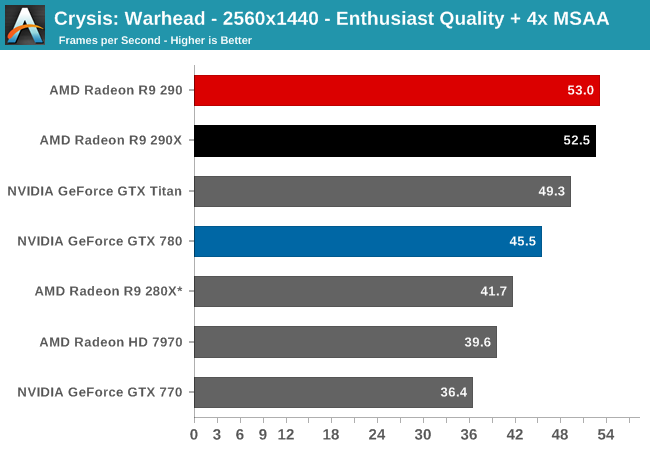
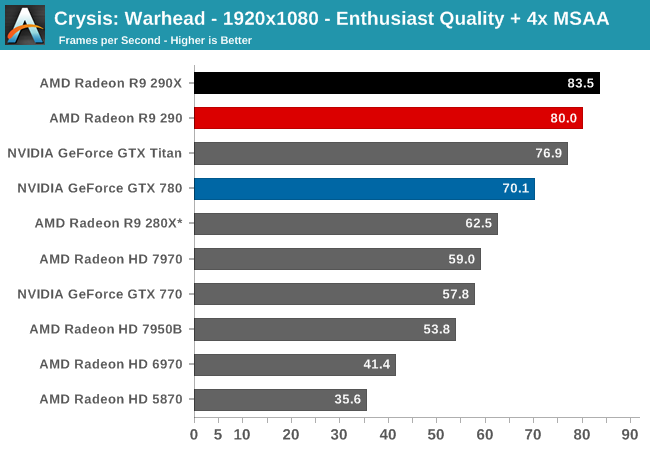
Unlike games such as Battlefield 3, AMD’s GCN cards have always excelled on Crysis: Warhead, and as a result it’s a good game for the 290 right off the bat. Furthermore because the 290X throttles so much here, coupled with this game’s love of ROP performance, the 290 actually beats the 290X, if only marginally so. .5fps is within our experimental variation (even though this benchmark is looped multiple times), but it just goes to show how close the 290 and 290X can be, and furthermore how powerful the higher average clockspeeds can be in ROP or geometry bound scenarios. Graphics rendering may be embarrassingly parallel in general, but sometimes a bit narrower and a bit higher clocked can be the path to better performance.
Meanwhile because the 290 does so well here, it makes for another sizable victory over the GTX 780, beating it by 16%. Further down the line the GTX 770 is beaten by 46%, and the 280X by 27%.
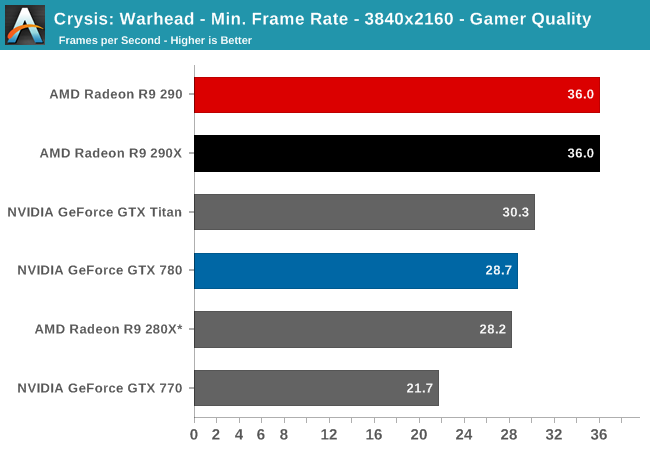
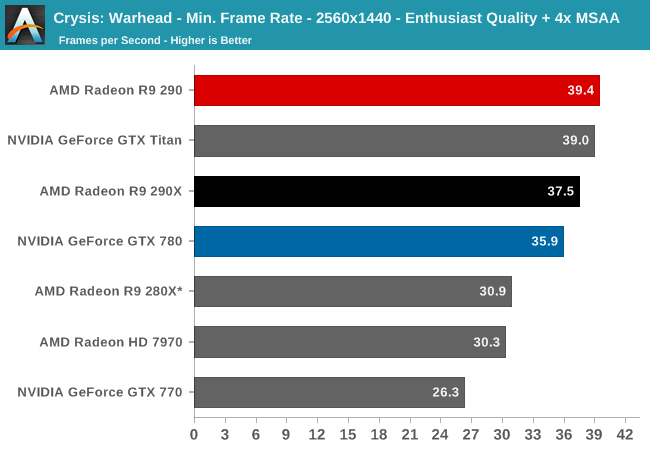
Moving on to our minimum framerates, the 290 actually extends its lead over the 290X. Now minimum framerates aren’t as reliable as average framerates, even in Crysis, so our experimental variation is going to be higher here, but it does once again show the advantages the 290 enjoys being clocked higher than the 290X under a sustained workload. Though on the other hand the GTX 780 catches up slightly, closing the gap to 10%.










295 Comments
View All Comments
DMCalloway - Wednesday, November 6, 2013 - link
Not sure how to interpret your analogy. Heat is measured in watts (energy) needing dissipation. This card is running up to 95*C while drawing around 50 more watts of power than a 780 . The 780 while drawing 50 less watts of power is running up to 80*C. Out of the gate the heat sink on the R290 is going to have to be at LEAST 20% more effective than the current 780 heat sink, and this thermal excess is still being pumped into the case.Galidou - Friday, November 15, 2013 - link
Well as I can see you are rather unfamiliar with power leakage due to temperature... anyway I won't get into the subject, I'll let you google it. Getting a card to run a lot cooler at the same frequencies can reduces power usage depending on how bad it affects certain node.A 20 degree celsius difference can have a great impact on power usage which I think might turn the tide around. In 28nm design, power leakage has been a bigger problem than before, probably a reason why Nvidia has been using better reference coolers thus, enhancing the performance/watt for the last generations of video cards.
That is the basis of my previous analogy.
TrantaLocked - Tuesday, November 5, 2013 - link
With the card in the case, with headphones on, with sounds/music from the game playing, hearing the 290 or any card would be tough. I know what loud video cards sound like (I owned the 4890 with a single fan design, and I always ran the fan at manual 40%-50% speed for gaming), and when playing a game with headphones the sound is barely audible and definitely not distracting.Calinou__ - Tuesday, November 5, 2013 - link
I have a reference 570 in a sound dampened case and a headset and I can easily hear it, even at idle (40% fan speed)... and I guess the R9 290 is more noisy.Galidou - Tuesday, November 5, 2013 - link
A reference 570 if not cleaned regularly(once every two months) goes easily up to 62 db. GTX 480 went up to 64 db(brand new) and Nvidia fans praised it even if AMD fans were saying it was loud, nothing new in here... Nvidia fans once said that 64 db is ''nothing'' for a good performing card... Look at them now speaking and whining about the same situation, really fun to see the tides turn around...That was in a time when reference coolers where much more used and represented a MUCH bigger % of the market, I would never buy an AMD reference cooled card. Nvidia fans started to care about noise and temperature when they got the 600 series out and for the first time had an advantage.
Finally - Tuesday, November 5, 2013 - link
Whoever buys a card with the default fan? Get one with a custom design and problem solved. How hard is that?Aikouka - Tuesday, November 5, 2013 - link
Anyone that buys it right now? =Pkmmatney - Tuesday, November 5, 2013 - link
I used to think that too, until I actually bought a loud HD4890. I ended up having to get an Accelero, which made it dead quiet. My current NVidia based card is also really loud, but I fixed that buy underclocking it most of the time. Really loud cards are just not fun to deal with. I'd wait for third party cards to come out with better cooling solutions.hoboville - Tuesday, November 5, 2013 - link
Except that it's hot, noisy, and basically pointless to overclock because it's as loud as a medium party without music. So as it is, it's a bad card.However, since it's only $400, one could go out and buy a water cooling setup and have a card faster than the 290x for about the same or less money. For Titan money, you could get a second 290 and add some more rads to your setup. The thing is...if you do want to OC (and why wouldn't you with water cooling?), you'll have to dissipate over 800 watts of heat...
Slomo4shO - Tuesday, November 5, 2013 - link
Well done AMD. Competition at its finest!